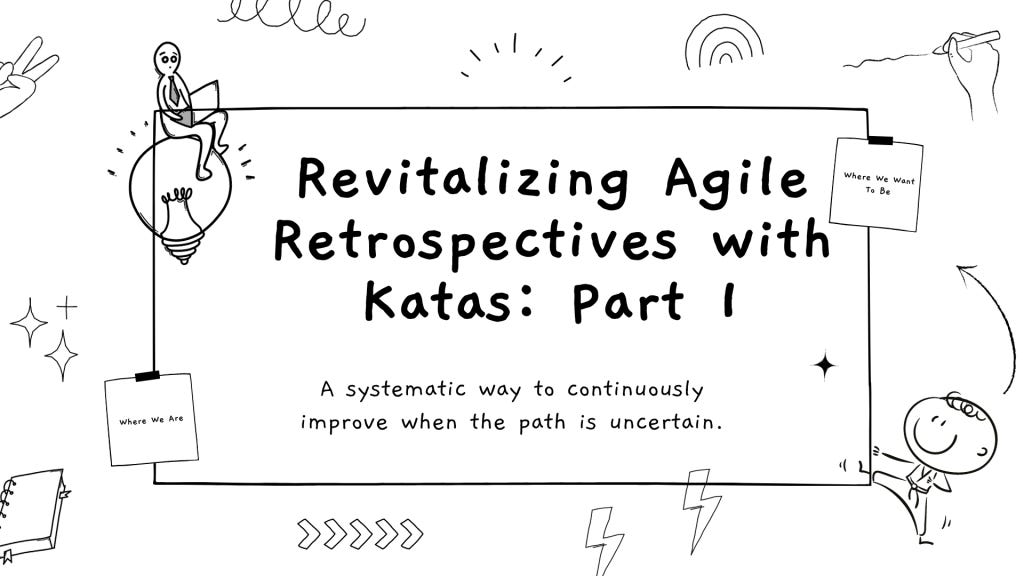Revitalizing Agile Retrospectives with Katas: Part 1
Retrospectives have been a cornerstone for continuous improvement for Agile teams. They are the sacred moments for reflection, adaptation, and connection. Yet, many teams report that retrospectives feel ineffectual, leaving them running in circles rather than advancing forward. Why is this, and how can we change it?
The Traditional Woes of Retrospectives
Games Over Deep Thinking: Engaging and interactive? Sometimes. Conducive for deep analysis and thoughtful planning? Perhaps not. Many retrospectives deploy games and activities, but sometimes, they overshadow the core objective. While some teams may appreciate the light-hearted approach, the main goal often gets overshadowed by the "fun."
Long Lists and Scattershot Approaches: Retrospectives can quickly become a catalog of complaints and ideas, followed by votes to prioritize them. This approach can scatter the team's focus, preventing deep dives into any issue.
Picking New Problems Every Sprint: One prevalent challenge is shifting attention from one problem to another, usually before the previous one gets truly resolved.
Reactionary Over Proactive: Instead of focusing on root causes or long-term objectives, many retrospectives become fixated on the issue of the week. As a result, teams often find themselves addressing symptoms rather than root causes.
The Toyota Kata: A Scientific Approach to Improvement
Kata: Derived from the Japanese term meaning "form", a Kata in the context of TPS (Toyota Production System) and Lean refers to a structured routine or practice aimed at achieving specific goals and continuous improvement. In martial arts, a Kata refers to a detailed choreographed pattern of movements, practiced alone or within pairs. Similarly, in the Lean methodology, it is about practicing structured problem-solving methods repeatedly until they become second nature, ensuring consistent results and constant evolution. Toyota Kata is a way of coaching people and fostering a culture of continuous learning and improvement through coaching and deliberate practice.
At its core, the Toyota Kata, also called the Improvement Kata, is about a scientific approach to continuous improvement. It introduces a systematic way of thinking and acting to achieve challenging goals amid uncertainty. Here are its foundational questions:
What are we trying to achieve?
Where are we now?
What's currently in our way?
What's our next experiment, and what do we expect?
When can we see what we've learned from that step?
By utilizing the Toyota Kata, teams can steer clear of the traditional pitfalls of retrospectives:
Focusing on deep thinking ensures that improvement topics are selected and analyzed critically, ensuring they align with broader objectives.
Its structure prevents scattershot approaches. Instead of juggling multiple issues, the team concentrates on systematic problem-solving.
The iterative nature of the Toyota Kata ensures that problems are tackled thoroughly before moving on, preventing the constant shifting from one issue to another.
Lastly, the methodology encourages a proactive stance. By identifying root causes and anticipating challenges, teams can strategize effectively.
Using the Improvement Kata
As we wrap up this introductory exploration into the Toyota Kata and its transformative impact on Agile retrospectives, it's clear that our journey is just beginning. Looking ahead, I'm excited to share two more in-depth explorations in this series:
Article 2: 'Applying the Improvement Kata: A Real-World Example' - In the next installment, we'll take a step beyond theory into practice. I will share a personal narrative demonstrating how the Improvement Kata, illustrated through the Improvement Kata Canvas, can be applied in real-world scenarios. This article will provide a detailed example of the Improvement Kata in action, offering insights and practical takeaways that you can apply in your own professional context.
Article 3: 'Integrating the Improvement Kata with Scrum' - The third article will specifically focus on integrating the Improvement Kata within Scrum events. We'll delve into how this methodology can enhance each Scrum event, from planning to retrospectives, and bring a new level of efficiency and effectiveness to Agile teams. This piece will be particularly valuable for those looking to deepen their Scrum practices with continuous improvement and lean thinking principles.
References
Rother, M. (2010). Toyota Kata: Managing People for Improvement, Adaptiveness, and Superior Results. McGraw Hill Professional.
Rother, M. (2015) Improvement Kata Handbook. [Online] Available at: http://www-personal.umich.edu/~mrother/Handbook/Full_IK_Handbook_v32.0.pdf [



